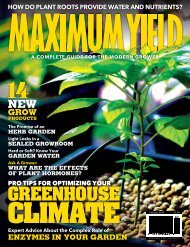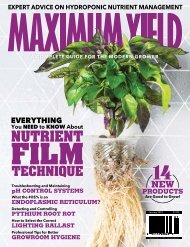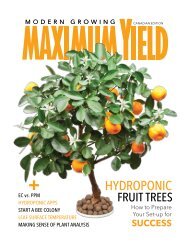Maximum Yield Modern Growing | Canadian Edition | May June 2017
In this issue of Maximum Yield, we cast a wide net to bring you the best and latest information possible to help you get started growing your own food. From the basics like cleaning your equipment to the best methods for preparing your plants to live outdoors, to more advanced topics like lighting and nutrient delivery, there is something in this issue for all levels of grower.
In this issue of Maximum Yield, we cast a wide net to bring you the best and latest information possible to help you get started growing your own food. From the basics like cleaning your equipment to the best methods for preparing your plants to live outdoors, to more advanced topics like lighting and nutrient delivery, there is something in this issue for all levels of grower.
You also want an ePaper? Increase the reach of your titles
YUMPU automatically turns print PDFs into web optimized ePapers that Google loves.
Airflow During the<br />
“Night” Period<br />
Regardless of the scope of a light deprivation<br />
operation, all cultivators need to<br />
consider airflow in their gardens when<br />
the tarp is pulled over the canopy during<br />
nighttime simulation. This is because<br />
the tarp hinders all airflow from outside<br />
the canopy, presenting challenges with<br />
humidity and subsequent issues with<br />
mold and mildew. To remedy these<br />
concerns, growers must employ intake<br />
and outtake fans similar to those found<br />
in indoor growrooms to ensure a steady<br />
exchange of air when the coverings are<br />
drawn. When choosing the size of inline<br />
fans for intakes and outtakes, gardeners<br />
should use similar considerations as seen<br />
with indoor growing. Exhaust fans should<br />
completely exchange the air in a light<br />
deprivation garden in five minutes or<br />
less. Depending on the size and the structure<br />
of a garden, intakes and outtakes<br />
can be mounted on the framing system or<br />
simply placed on the ground. However,<br />
for air to move efficiently, it’s essential<br />
that the ducting connected to these fans<br />
is long enough so that the ends are not<br />
covered by the tarp when it is pulled<br />
over the frame.<br />
Light deprivation greenhouses essentially<br />
signal plants that seasons are<br />
changing earlier than they actually are,<br />
so growers can manipulate their crops to<br />
produce more robust and frequent crops.<br />
Keep in mind that some plants react<br />
better to light deprivation methods than<br />
others, and that issues such as excessive<br />
heat or humidity, lack of oxygen to<br />
the roots, and pest infestations can be<br />
prohibitive. Once dialed in, however,<br />
light deprivation technology can be<br />
used to harvest early and often, particularly<br />
in late summer and early fall.<br />
grow cycle<br />
49


















